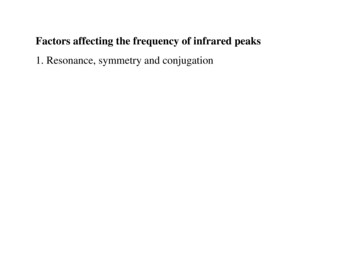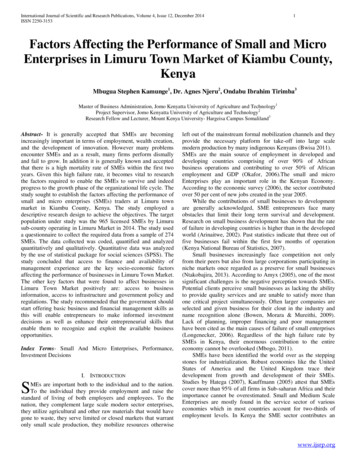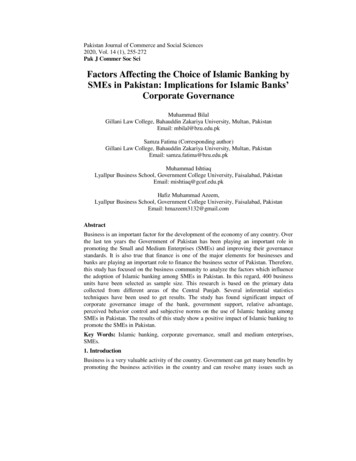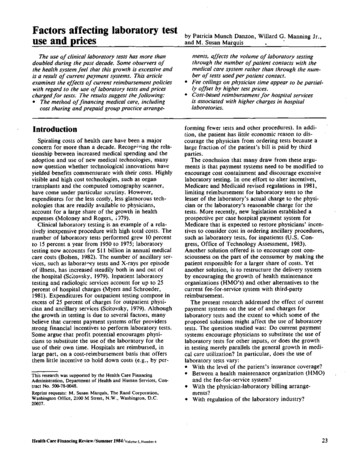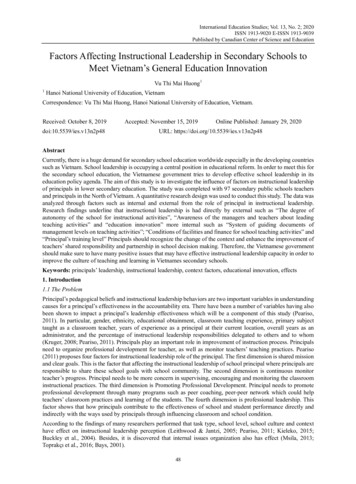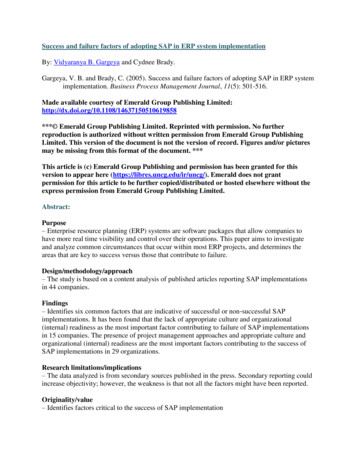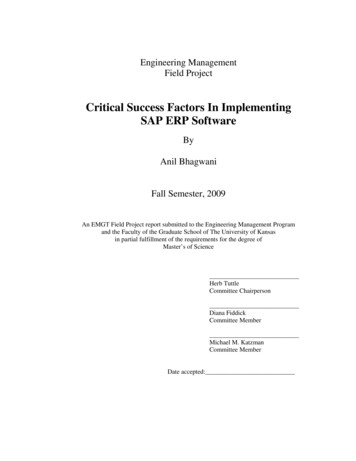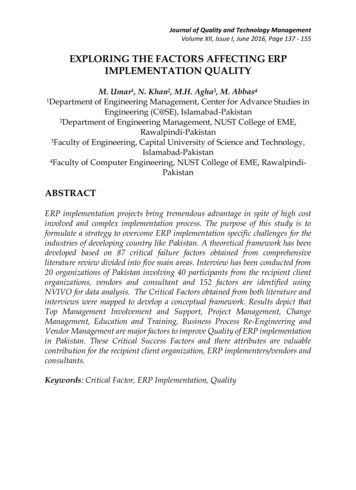
Transcription
Journal of Quality and Technology ManagementVolume XII, Issue I, June 2016, Page 137 - 155EXPLORING THE FACTORS AFFECTING ERPIMPLEMENTATION QUALITYM. Umar1, N. Khan2, M.H. Agha3, M. Abbas41Department of Engineering Management, Center for Advance Studies inEngineering (C@SE), Islamabad-Pakistan2Department of Engineering Management, NUST College of EME,Rawalpindi-Pakistan3Faculty of Engineering, Capital University of Science and Technology,Islamabad-Pakistan4Faculty of Computer Engineering, NUST College of EME, RawalpindiPakistanABSTRACTERP implementation projects bring tremendous advantage in spite of high costinvolved and complex implementation process. The purpose of this study is toformulate a strategy to overcome ERP implementation specific challenges for theindustries of developing country like Pakistan. A theoretical framework has beendeveloped based on 87 critical failure factors obtained from comprehensiveliterature review divided into five main areas. Interview has been conducted from20 organizations of Pakistan involving 40 participants from the recipient clientorganizations, vendors and consultant and 152 factors are identified usingNVIVO for data analysis. The Critical Factors obtained from both literature andinterviews were mapped to develop a conceptual framework. Results depict thatTop Management Involvement and Support, Project Management, ChangeManagement, Education and Training, Business Process Re-Engineering andVendor Management are major factors to improve Quality of ERP implementationin Pakistan. These Critical Success Factors and there attributes are valuablecontribution for the recipient client organization, ERP implementers/vendors andconsultants.Keywords: Critical Factor, ERP Implementation, Quality
Exploring the factors affecting ERP implementation Quality1) INTRODUCTIONERP is a complete business solution that deals with all the major businessfunction of an organization. It is an integrated, configurable andcustomizable package that is highly responsive to the changing businessneeds (Thomas, 1998). ERP provides competitive advantage to theorganization through improved control and better visibility in theinformation. It brings robust change and dramatic improvement that leadsto innovation and smart decision during operations (Chung, 2007). Thereare various vendors that provide ERP solutions. However, the mainvendors are SAP, Microsoft Dynamic, Oracle, JD Edward and People-softetc. SAP captures the major market share of the world (H. Davenport,1998). AMR research group published a report in which market share ofERP in 2006 was 28.8 billion and in 2011 it has grown into 47.7 billion.Due to this reason ERP in considered one of the most importantinnovations of the previous decade (Al-Mashari, 2002).Literature shows that implementation of ERP one of the most complexdecisions that organizations take, because these projects are consideredlarge scale projects in terms of scope, cost, time and people involved in theimplementation process. ERP implementation demands strongcommitment by the all the resources from the top management to the lowermanagement (Cooke et al, 2001). It’s a huge transformation that bringstremendous change in all aspects of the organization (Majed, 2003). ERPappears to be the most widely accepted solution in both developed anddeveloping countries. However, the comparative growth is not aspromising as in the technologically advanced countries due to nonavailability of comprehensive guidelines for developing countries. Most ofthe research is devoted for developed countries and only 10-15% of ERPGlobal research is dedicated for Developing countries (Zhe Zhang, 2005).Literature also points out some additional challenges that developingcountries has to face like economic, culture and infrastructure issues thatcause failure and part of important concern (Panorama ConsultingSolutions,“2014)( P. Soja, 2008). Another reason for high ERP failure rate isthe lack of availability of slandered guidelines for developing countries.Public and government sector organizations are also tending to movetowards ERP for real time information and to gain better administrativecontrol (Gholamhosein, 2010). Such organizations have more socialobligations, public accountability, and higher legislative and uniqueculture (Saquib and Rubana, 2011). Hence it can be concluded that ERP138
Journal of Quality and Technology Managementimplementation is huge transformation coupled with high risk and cost.However, against all this, it can deliver high outcomes if it is implementedin organized way.There are various studies available for ERP implementation and about itsfailure factors in different countries like India, China, Saudi Arabia, Jordan,Sri Lanka, Oman, Malysia, Iran, Egypt and Tunisia (Amin et al, 2012). Butcurrently no study is available that is dedicated for the industry inPakistan. The main purpose of the present study is to identify the criticalsuccess factors that improve the quality of ERP implementation. CriticalSuccess factors are defined as “The few critical areas where things must goright for the business to flourish” (J.F.Rockhart, 1979). The study is dividedinto different sections contains Literature Review, Research Methodology,Conclusions with Discussion and Recommendations at the end.2) LITERATURE REVIEWLiterature provides strong evidence of high failure rate of ERPimplementation projects i.e. 70% of ERP projects failed to provide theexpected benefits and three quarters are not able to gain success. Researchreport shows that these projects 178% over budget and face delay 2.5 timesas that planned by giving only 30% of the promised benefits (Al-Mashari,2002). However, there various benefits due to which organizations shiftstowards ERP like better customer care and retention, improve financials,,improved productivity, better information management, improveddecision making, better asset management, ease of growth or expansionwith enhance flexibility, accurate and quick transactions, reduction in cycletime and head count, less resources and improve revenue(Shang et al,2000). ERP implementation success relies not only on organizationalinternal factors like project management, top management involvementetc. but also organizational external factor like role of vendor, consultantcommitment etc. Similarly, IT governance plays vital role for the successfulimplementation of ERP (Wen-Hsien, 2013). There is huge growth inenterprise system projects across the globe in the last two decades resultedinto significant increase in ERP market share (Gholamhosein, 2010).However, ERP adoption in developing countries like Pakistan is lowbecause of high cost involved, lack of knowledge of people using it, cultureintegration etc. (Rajapakse and Peter, 2005). ERP implementation growthrate in India is around Rs. 40, 0000 million and seems to be growing in with25% growth rate in upcoming three to four years (Suraj, 2013). Indian 139
Exploring the factors affecting ERP implementation QualitySME’s are also shifting towards enterprise system to gain competitiveadvantage using real time information and to improve customer responsetime (P.T. Kale et al, 2010). There are different factors that impact thesuccess of ERP implementation depends upon region, size of project,people involved in the project. However, there are some factors that arecommon to gain desired outcome from the ERP project. Firstly, it is veryimportant for an organization to choose the right ERP package that isaligned with the corporate culture, flexible enough to full fill theorganizational needs and covers all its major business functions (Jamie,2013).A research study conducted in 18-different parts of the world and “TopManagement Commitment” and “Education and Training” were the mostcommonly cited factors for the success of ERP implementation (Ngai et al,2008). How much the best business practices are customized also playimportant role for the success of ERP project. Organization should avoidunnecessary customization (Rothenberger, 2009). A tremendous effort forchange is required to shift people on best business practices and if thischange is properly managed then it will bring dramatic effect on theoutcomes of ERP project. To achieve the desired goal for an organization,the consultant and the client should work on agreed upon strategy and thatimplementation will play important role for ERP success (Zain, 1995).Before going to CSF and CFF it is important differentiate success andfailure of ERP implementation.2.1) Success of ERPDifferent stakeholder defines ERP project success from their own way. Forproject manager if the project is completed with in time and within budgetthen the project is successful. For users point of view if the system is userfriendly and brings efficiency in daily tasks then the project is successful,business owners rates the project success in terms of ROI (Jiwat, 2013).However, there are some common areas that define the success of ERPprojects like system quality, information quality, service quality, tacticalimpact and strategical impact (Zainal and Gede, 2012) [17]. Another studyshows that if an organization is not able to obtain the desire objectives thenit should be considered as failed implementation (Suraj, 2013). Similarly,there are some other researchers that link success with obtainingsubstantial amount of organizational objectives (Thomas, 1998), (E.Umbleet al, 2003). However, it is important for an organization to choose the right140
Journal of Quality and Technology ManagementERP package that is aligned with the organizations need and bringspositive financial return on investment (Suraj, 2013).2.2) Failure of ERPIt is beyond all doubts that ERP brings tremendous advantage butorganizations avoid to implement ERP due to complex implementationprocess and high failure rate. ERP projects faced either complete failure orpartial failure. Complete failure means either the projects failed completelybefore implementation or implemented in such a way that the companyhas to face huge financial loss. Partial failure means misalignment inprocesses cause disruption in routine operations (Vidyaranya, 2005). Highfailure rate of ERP implementation projects has generated lot of interest inthe research community and this thing becomes a source of increment inthe body of knowledge (Ann and Peter, 2003). There are different reasonsof ERP implementation failure available in literature. One of the mainreasons that came out is the misalignment of processes in developing andunder developed countries while using foreign ERP. The internal structureof the processes embedded in the system does not full fill the needs ofunderdeveloped or developing countries (Y. Xue, 2005).There are lots of worlds renowned companies faced ERP implementationfailures like Nike, FoxMayer, Hershey and many more. This failureresulted into jeopardizing the business core operations and shifted thecompany towards bankruptcy (M. Cotteleer, 2002). ERP implementationfailure rate in US firms is also very high ranging from approximately 50 to75 %. Literature depicts that 51% of US firms perceived their ERPimplementation as not successful and 70% of all ERP projects fail to be fullyimplemented (E.Umble et al, 2003). Standish research group rates ERPsuccess in China approximately 10%. Another study is conducted based onthe data taken form 117 companies having ERP projects and the resultsshows that 55% projects not able to achieve the desire objectives, 25% facedbudget overrun and 20% projects stopped abnormal (Cooke et al, 2001).Panorama Consulting Solutions is a well-known consulting firmspecializing in the ERP, their latest surveys in 2015 shows that more than55% of projects budget overrun whereas above 75% of project scheduleoverrun and about 41% of the respondents have a point of view that ERPdelivered half of the expected benefits. The last five year data of panorama 141
Exploring the factors affecting ERP implementation Qualityindependent research provides the average cost of ERP implementationprojects that is about 6.1million whereas the average duration of the ERPimplantation projects has been 15.7 months. The research results showsthat out of these project 58% of project have crossed the planned budgetand 65% of the project faced delay and could not be completed accordingto their planned duration. There are 53% of the organization that could notachieve half of the benefits planned at the start of the project (PanoramaConsulting Solutions, 2014). Such high alarming ERP implementationfailure rate got overwhelming attention of researchers. Literature alsoshows that there is only 6% article that has explored CSF in ERPimplementation projects from year 1998 to 2007 [50] that shows the lessresearch work done in this area. When the similar type study wasconducted for CFFs then it was found even less than 1% (G. Pan et al, 2008).3) RESEARCH METHODOLOGYQualitative method of research has been adopted in the study. It is moreflexible approach in which respondents verbal and non-verbalcommunications have been analyzed their natural settings (N. K. Denzinand Y. S. Lincoln, 2014). Another good thing about qualitative research isthat it explores, interpret and obtain a detail and deep understanding of theproblem (Strauss, A. & Corbin, 1990). First of all rigorous in depthliterature review has been conducted to identify the critical failure factorsduring ERP implementation process and total 87 critical failure factorshave been identified . These factors have been divided into 5-groups basedon the personal judgement and expert opinion. The factors are lack of topmanagement involvement, poor project management, poor changemanagement, poor business process reengineering and lack of education &training. The purpose is to identify the failure reasons and develop astrategy to handle these critical factors.The dependent and independent variables identified as shown in theTable-1.142 p
There are lots of worlds renowned companies faced ERP implementation failures like Nike, FoxMayer, Hershey and many more. This failure resulted into jeopardizing the business core operations and shifted the company towards bankruptcy (M. Cotteleer, 2002). ERP implementation
